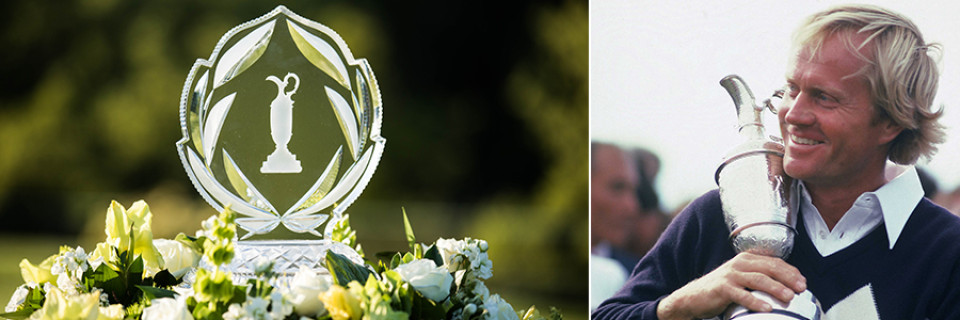Latest News


July 18, 2017
The Claret Jug
Much has been made of the resemblance between The Memorial Tournament presented by Nationwide and the Masters tournament. From the immaculately maintained, spectator-friendly golf course to the invitational format to the celebration of the game’s heroes and traditions, Muirfield Village Golf Club is an abiding tribute to the Augusta National Golf Club.
But when Jack Nicklaus founded his tournament here in Dublin, Ohio, he had at least one other source of inspiration. Take a close look at the logo. There, enclosed at the center of a laurel wreath, is the silhouette of a trophy that has been prized and pursued by every prominent player in the history of the game. The enduring symbol of the British Open, it is the Claret Jug, or The Golf Champion Trophy as it is properly known at its home.
Jack hoisted the Claret Jug for the first time in 1966 at—not coincidentally—Muirfield, Scotland, after the first of his three Open victories. Correction—he thought he hoisted the Claret Jug. The truth is, Jack has never touched the Claret Jug. Neither has Tiger or Seve or Arnie or Hogan or Sarazen. The silver trophy they were awarded is an imposter, a replica. One of five replicas. Or 25. Or maybe more.
It’s all a bit complicated, you see, the story of the Claret Jug.
When the British Open began back in 1860, the jug didn’t exist. Instead, the eight competitors who assembled at the 12-hole Prestwick Golf Club played for a belt—The Challenge Belt—a cummerbund-sized sash crafted of red Moroccan leather and festooned with silver emblems. The belt was purchased and presented by the members of Prestwick, site of the first 11 Opens. The champion golfer was allowed to keep it for a year, but a provision said that anyone who could win the title three years in succession would be granted permanent possession of the belt—and that is exactly what Young Tom Morris did in 1868, 1869, and 1870.
That left the tournament organizers in a spot of bother, exacerbated by the fact that other sites had begun to show interest in hosting the big event. At the 1871 spring meeting of the Prestwick Club, one of the members, a patently thrifty Scot, proposed that “in contemplation of St. Andrews, Musselburgh, and other clubs joining in the purchase of a Belt to be played for over four or more courses, it is not expedient for the Club to provide a Belt to be played for solely at Prestwick.”
So they didn’t. And thus bereft of a proper trophy, they didn’t hold a championship either! It was another year before a decision finally was made to rotate the event among three clubs—Prestwick, the Royal and Ancient Golf Club of St. Andrews, and the Honourable Company of Edinburgh Golfers (then based at Musselburgh, now Murifield)—with each club contributing ten pounds toward the purchase of a new trophy, a sterling silver claret jug.
However, agreement on the trophy was reached only two days before the Open was due to be played, with the result that Young Tom Morris, again the victor at Prestwick, was presented only a medal, along with the winner’s share of the purse, eight pounds. Not until the 1873 Open Championship, won by Tom Kidd at St. Andrews, did the new prize make its debut.
The champions were allowed to keep the jug for the year of their reign. A lesson had been learned, and there was no “three-wins-in-a-row-and-you-get-to-keep-it” clause. Had there been one, the organizers would have relinquished two trophies within the first decade as both Jamie Anderson (1877-1879) and Bob Ferguson (1880-1882) scored hat tricks.
In 1927, the Royal & Ancient Golf Club (which by then had assumed control of the championship) decided that the original Claret Jug had become sufficiently valuable that it should be kept permanently in the R&A clubhouse. A replica—90 percent the size of the original—was commissioned for presentation to the champion. Thus, the last player to have yearlong possession of the real Claret Jug was Bobby Jones, who won the second of his three titles in 1926.
One cannot help but wonder whether the R&A’s decision to guard its treasure had something to do with the fact that in 1925 the U.S. Open trophy (then also in the possession of Jones) had been destroyed in a fire at the East Lake Golf Club or, perhaps more to the point, that in 1926 Walter Hagen had “lost” the PGA Championship trophy in a New York taxi cab (it was found four years later in a Detroit warehouse owned by the Walter Hagen Company). In any case, the sequestering of the original jug was undoubtedly a prudent move inasmuch as the winner of the Open Championship in both 1928 and ’29 turned out to be the mercurial Hagen.
No one at the R&A knows for sure how it happened—at least, no one is admitting to it—but when Tom Watson (a two-time winner of the Memorial Tournament) won in 1982, he was awarded not the replica but the original claret jug. That winter, while making a practice swing in his Kansas City den, Watson bumped it and it fell to the floor, suffering a major bend in its throat. Rather than trust the trophy to a silversmith, Watson took it to his basement workshop, wrapped it in felt, put it in a vice, and bent it back without crimp or crease. “No one knew the difference,” he said.
“When I won in 1987,” says Nick Faldo, “I immediately had to give the jug back for a few months because there were dings in it.” (One rather sizable dent is rumored to be the result of an overly exuberant backyard game of Australian Rules football.) Happily for Faldo, he would gain possession of the prize twice more—in 1990 and ’92—before having to return it to Norman in 1993. And the thrice-married-and-divorced Englishman managed to get his own sort of pleasure from the jug—by sleeping with it. A few years back, he explained his thrill to the BBC: “When you wake up in the morning, you can put your hand out in the dark and say, ‘Bloody hell, it’s the Claret Jug’.”
After winning the Open at St. Andrews in 1995, John Daly is said to have taken the jug across the Tay Bridge to Dundee for dinner at McDonald’s but when asked whether he’s ever filled it with the beverage of his choice he replied, “Nah, it’s so small you can’t get anything into it hardly.”
At Royal Lytham in 1996, Daly relinquished his title and prize to Tom Lehman (1994 winner of the Memorial Tournament) who made virtuous use of the jug, as a centerpiece for the head table of a charity dinner he hosted in Minneapolis. After the dinner, however, Lehman got involved signing autographs and forgot the trophy. A family friend rescued it and passed it on to Lehman’s wife Melissa who passed it on to Alissa Herron, sister of Lehman’s fellow Minnesotan and tour professional Tim Herron. At about 2 a.m., Lehman received a phone call from the Minneapolis police—someone had spotted a young woman and friends drinking from the Claret Jug at a local bar. Once Ms. Herron was confirmed as the perpetrator, everything was fine—in fact, all the police had their pictures taken with the jug.
The same year Lehman’s daughter Holly decided to play dolls with the Claret Jug and a couple of dad’s Ryder Cup replicas. When Tom got home the jug was leaning at him on a 45-degree angle. A trip to the local jeweler straightened it out.
Perhaps no champion has had more fun with the jug than 2002 winner Ernie Els, another past Memorial winner, who took it on a bibulous jaunt around his London neighborhood the day after his victory at Muirfield and then packed it with him for a global tour worthy of the Stanley Cup. “A lot of friends around the world have had sips out of that jug,” he says. “We had so many parties I’m amazed it never got chipped, but when I handed it back the next year I had to give it a helluva cleaning because we’d poured so many different drinks inside it.”
News
April 30, 2025
World No. 1 Scottie Scheffler set to defend his title at the Memorial Tournament presented by Workday
April 15, 2025
Legends Luncheon presented by Nationwide raises $1.45 million for Nationwide Children’s Hospital and Nicklaus Children’s Health Care Foundation alliance
February 13, 2025
Registration now open for 2025 FORE! Miler presented by The Ohio State University Wexner Medical Center and The James
Presenting Sponsor

Official Tournament Partners





